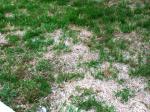COLUMBIA, Mo.– Toxic fescue pastures that cut Missouri livestock production are the target for four schools set to start at the end of March.
The Alliance for Grassland Renewal aims to teach how to eradicate and replant fescue pastures for better production.
Until now, most forage lessons have been on ways to alleviate loss.
“We have several novel-endophyte fescue varieties that eliminate the problem,” says Craig Roberts, University of Missouri Extension forage specialist.
In four one-day schools, Missouri producers will learn steps for eradication and reseeding. The schools will be held March 31, Mount Vernon; April 1, Cook Station; April 2, Columbia; and April 3, Linneus.
The intense schedule brings together state and national teachers to cover problems and solutions.
Missouri extension specialists brought together all the groups that have worked separately on fescue toxicosis.
The toxicity has been recognized for years, but only recently did plant breeders release a number of fescue varieties to replace the long-established Kentucky 31. That grass, which belatedly was discovered to carry a toxic fungus, is now the dominant pasture grass in the state.
“We’ll teach a plan for step-by-step replacement,” Roberts says. No farm can replace all pasture at once and maintain their herds, he notes, but they can start with pastures that benefit the most.
“Kentucky 31 is one tough grass,” Roberts says. That’s why it is popular—because it survives. But a downside is that it cuts calf growth by at least a half-pound per head per day.
“At today’s prices, with feeder calves selling for nearly $2 per pound, that’s costly to Missouri farmers,” he says. “With replacement, we will have huge economic impact. The time is right to take action.”
Replacing pastures, killing the old and seeding the new, is a yearlong process.
University of Missouri researchers developed a spray-smother-spray method of eliminating K-31. Not only must the living plants be killed, but also the seed in the soil must be eradicated.
Then the new seeding must be established. The Missourians have a recipe for that as well. A critical part is to use no-till planting to prevent soil erosion. Then the tiny seed must be planted about one-eighth inch deep in the soil. “Depth is critical,” Roberts says.
A part of the Alliance workshop will be on how to adjust seeding drills. “Planting too deep is the biggest source of failure,” he says.
The day’s agenda covers two major parts. First is establishment. Then grazing management of the new stand is critical. New varieties, because they are not toxic, can be overgrazed. The reason K-31 survived is that the toxin discouraged grazing, Roberts says.
The teaching plan also covers fescue toxicosis, testing, seed quality, new products, possible government incentives and farmer economics.
The schools run 9 a.m. to 5 p.m. at each location. A fee and advance registration is required.
Farmers who have made fescue conversions will be on the panel. “Farmers are our best teachers,” Roberts says. “They have made it work—and learned the dollar returns. Their farm records show the value. Rewards for conversion are high.”
Besides farmers, the teachers are from MU Extension, USDA Natural Resources Conservation Service and agribusinesses. The Alliance not only educates but also sets quality standards for the new seed.
Two trial schools were held last fall. The new schools are expected to fill quickly.
School locations and contacts are:
- MU Southwest Research Center in Lawrence County. Carla Rathmann, 417-466-2148.
- MU Wurdack Farm in Crawford County. Will McClain, 573-775-2135.
- MU Beef Research and Teaching Farm in Boone County. Lena Johnson, 573-882-7327.
- MU Forage Systems Research Center in Linn County. Tamie Carr, 660-895-5121.
The research centers, all part of the MU College of Agriculture, Food and Natural Resources, have plots with new fescue varieties.
For more information about the schools, go to www.grasslandrenewal.org.
Read more http://extension.missouri.edu/news/DisplayStory.aspx?N=2122





